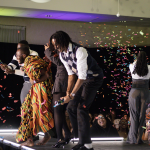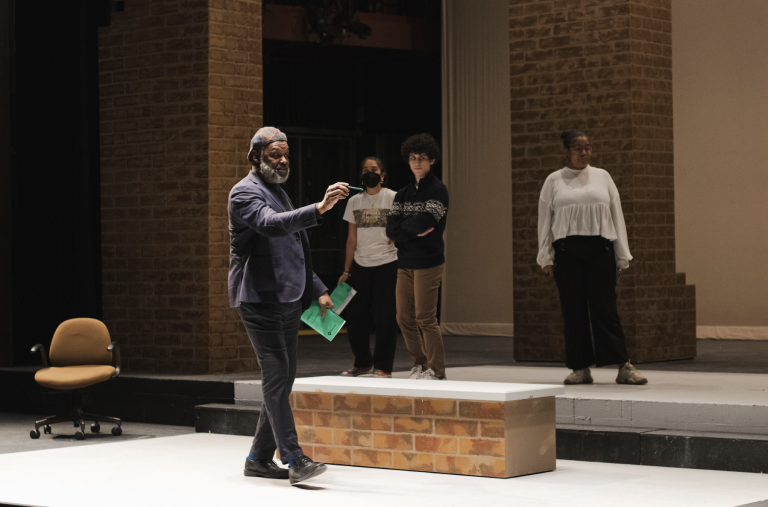TRIP SLAYMAKER ’18
A&E EDITOR
Fear is a powerful force in our lives, whomever we are. Seeping dread and confusion are constants in the minds of some, and nothing makes people more frightened than those things that they do not understand. What defines us is not what we are afraid of so much as how we respond to fear. Are we forced reflexively to look away? Or do we conquer these fears- face them head on and learn from the things about which we had been ignorant?
A good number of us learned that about ourselves last Wednesday, with the appearance of an unusual sight on campus. If you saw her, you did not forget her: A woman draped in shocking red from head to toe. She is the Red Chador: a vision of otherness devised by one of Trinity’s staff.
Walking slowly, sometimes stopping in archways, corners, even reportedly entering classrooms at times, the Chador made a long and slow journey across campus. Hundreds of students and staff passed her by, many of them vigorously avoiding eye contact, many of them nodding respectfully, and a few laughing unabashedly at the mysterious vision. The Red Chador even took a walk through Mather hall at around 12:30, peak lunchtime. The crowds seemed to part and swirl around her, raising eyebrows, and a small amount of alarm among the throngs. In what is often called the athletic section of the dining hall, the Chador was invited tremulously to have a seat and stay awhile. Always silent, the woman in red nodded and smiled darkly along with the conversation of the students, rising to leave maybe three minutes later.
Social media was flooded in minutes with images and short videos of the Chador, but few knew who or what she was. This mystery is of course a part of the art itself: The unknown needs to be shrouded in obscurity- it needs to be, well, unknown.
Anida Yoeu Ali is a visiting Assistant Professor in International Studies: a performance artist and self described “global agitator” who makes it her business to probe the minds of those who see her pieces. In the past she has made headlines by donning elaborate costumes and visiting locations all over the world in order to create her art. One exhibition followed the exploits of “The Buddhist Bug”, a hundred foot long creature created by Ali, which appears in photographs across Cambodia: from Angkorian temples to local schools and streets. Others see her dressed all in white and pushing a baby in a stroller through distant cities: this is the “White Mother”. Professor Ali is a Cambodian American, and her work often stems from a Cambodian context, and from notions of societal place and status in the worlds of religion, nationality, and everyday life.
The Chador was not alone, however. The entourage of photographers that circled the Chador from a distance were seeking to capture the art that will be on view at Austin Arts Center from November 4th to December 14th. After all, the Chador is an art piece- first comes the performance and then comes the photograph.
It would seem that the Red Chador herself, then, represents more than just a strange sight on campus. It is likely important information that a “Chador” is a full length religious gown worn most often by Muslim women. It is not unlike a burka, and the gown worn by the Red Chador herself is sequined and crimson, with a train that hisses dramatically over the ground. The image is both mystically charged and jarring, and instantly conjures images of faraway places and the exotic. It seems likely that raising questions about religious acceptance is a part of this work, and the common places and halls of Trinity seems above all an important place to examine this.
That said, some students expressed conflicting thoughts about the appearance. Diana Chandler, ’18 said that the Red Chador was probably trying to make a very interesting statement, and that “It’s in your face. You cannot ignore it…I think it’s very effective, but it depends on what your cause is. Her message was not entirely clear. With that said, If I had had the chance to speak to her, I think it would have been more clear…If she has a reason and a cause, then you can spread the message that way.” Winston Brewer, ’18 seemed most eager to learn what the piece is intended to say about Trinity as a whole. “When I first saw her I was wondering what was going on, then someone told me it was a political statement about our reactions to other cultures …I think she was trying to prove that Trinity students would have a bad reaction to her.” Brewer says that he felt most as though he was being called out: “I felt like I was being judged.”
Political statement or not, the Red Chador got some kind of rise out of just about everyone who encountered her. But therein lies the art: It seems most likely that the Chador is, in her essence, intended to make some defensive, and some curious and interested. Most of all, it is to be thought provoking. And so, now that the Chador has come and gone (presumably), Trinity is left to its thoughts. Those who spotted her, spoke to her, or avoided her are asked why they did so: as the subtitle of the exhibition asks, “What is it you fear?”
Wednesday, January 15 2025
The Student Newspaper at Trinity College in Hartford, Connecticut




+ There are no comments
Add yours